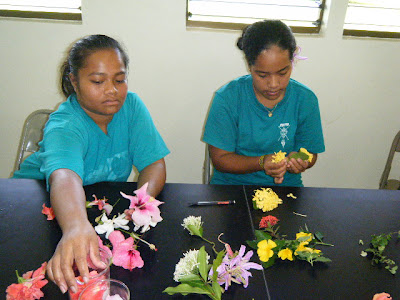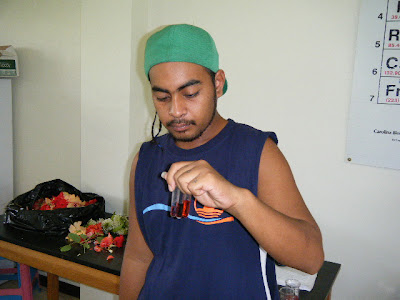Floral pigments as litmus solutions
Laboratory thirteen in physical science had the students collect flowers from around campus, produce floral solutions by boiling in water, and then test to see which floral solutions changed color for both a known acid and a known base. Teaching in the tropics makes this laboratory possible in both November and April, or even in July.
Achimy pours hot water on flower petals.
Sussy prepares petals for boiling.
Carlyne sorts out test tubes.
Adam with a floral litmus solution that turns magenta when an acid is added.
Rihter and Carlyne work with the known acid (lime fruit) and the known base (baking soda).
Elizabeth adds lime juice to a test tube held by Jason. Monaliza looks on.
Carlyne and Iumileen testing one of their floral solutions.
Loioshi and Evelyn work with the unknowns, attempting to determine whether they are acidic, basic, or neutral.
MaryHellan with a floral litmus solution.
Merlisa and Kioleen clean their flower petals for boiling.
Brian and Ceasar testing one their floral solutions for a color change as a result of lime juice being added.
A table full of flowers.
Iumileen with a color changing floral litmus solution.
Joshua working with a flower fluid that turns bright red in the presence of an acid.
Achimy pours hot water on flower petals.
Sussy prepares petals for boiling.
Carlyne sorts out test tubes.
Adam with a floral litmus solution that turns magenta when an acid is added.
Rihter and Carlyne work with the known acid (lime fruit) and the known base (baking soda).
Elizabeth adds lime juice to a test tube held by Jason. Monaliza looks on.
Carlyne and Iumileen testing one of their floral solutions.
Loioshi and Evelyn work with the unknowns, attempting to determine whether they are acidic, basic, or neutral.
MaryHellan with a floral litmus solution.
Merlisa and Kioleen clean their flower petals for boiling.
Brian and Ceasar testing one their floral solutions for a color change as a result of lime juice being added.
A table full of flowers.
Iumileen with a color changing floral litmus solution.
Joshua working with a flower fluid that turns bright red in the presence of an acid.
Lupe with a floral solution that turns green in the presence of a base, magenta in the presence of an acid.
This laboratory remains a favorite of the students. This term six of thirty-two picked laboratory thirteen as their favorite laboratory. Only one student chose thirteen as their least favorite laboratory. In the tropics we are blessed with many different flowers and colored leaves to try. For those in temperate climates, Fred Senese covers some of the options available. Senese also notes that onions and vanilla are olfactory pH indicators.


















Comments
Post a Comment